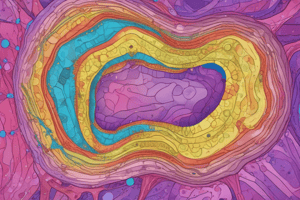Podcast
Questions and Answers
Which type of epithelium is found on the inner surface of the mouth, oesophagus, and blood vessels?
Which type of epithelium is found on the inner surface of the mouth, oesophagus, and blood vessels?
- Squamous epithelium (correct)
- Cuboidal epithelium
- Columnar epithelium
- Ciliated epithelium
Which type of epithelium forms the outer layer of the skin?
Which type of epithelium forms the outer layer of the skin?
- Stratified epithelium (correct)
- Cuboidal epithelium
- Columnar epithelium
- Glandular epithelium
In which structure is the columnar epithelium found?
In which structure is the columnar epithelium found?
- Tubules of the kidney (nephron) and salivary gland (correct)
- Outer layer of the skin
- Upper free surface of cells with minute hair-like processes
- Inner layer of the skin
Which type of epithelium is responsible for pushing mucus and air forward to keep the air passage free?
Which type of epithelium is responsible for pushing mucus and air forward to keep the air passage free?
Where is cuboidal epithelium involved in reabsorption of useful materials from urine and secretion of saliva?
Where is cuboidal epithelium involved in reabsorption of useful materials from urine and secretion of saliva?
What is the function of stratified epithelium?
What is the function of stratified epithelium?
Flashcards
Squamous epithelium location?
Squamous epithelium location?
Single layer of flattened cells; found in areas needing rapid diffusion and filtration.
Stratified epithelium function?
Stratified epithelium function?
Multiple layers of cells; protects against abrasion in areas of high wear and tear.
Columnar epithelium function?
Columnar epithelium function?
Epithelium with elongated cells; involved in absorption and secretion.
Ciliated epithelium function?
Ciliated epithelium function?
Signup and view all the flashcards
Cuboidal epithelium function?
Cuboidal epithelium function?
Signup and view all the flashcards
Stratified epithelium function?
Stratified epithelium function?
Signup and view all the flashcards
Study Notes
Epithelial Tissue Types and Functions
- Squamous epithelium is found on the inner surface of the mouth, oesophagus, and blood vessels.
- Keratinized stratified squamous epithelium forms the outer layer of the skin.
- Columnar epithelium is found in the structure of the oesophagus.
- Ciliated columnar epithelium is responsible for pushing mucus and air forward to keep the air passage free.
Cuboidal Epithelium
- Cuboidal epithelium is involved in reabsorption of useful materials from urine in the kidney.
- Cuboidal epithelium is involved in secretion of saliva in the salivary gland.
Stratified Epithelium
- Stratified epithelium provides protection against mechanical stress and abrasion.
Studying That Suits You
Use AI to generate personalized quizzes and flashcards to suit your learning preferences.




